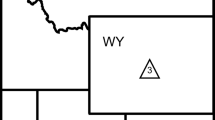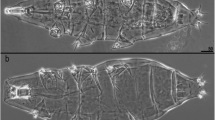Abstract
Tardigrade feeding apparatus is a complex structure with considerable taxonomic significance that can be schematically divided into four parts: buccal ring, buccal tube, stylet system, and pharynx. We analyzed the fine morphology and the tridimensional organization of the tardigrade buccal–pharyngeal apparatus in order to clarify the relationships between form and function and to identify new characters for systematic and phylogenetic studies. We conducted a comparative analysis of the cuticular structures of the buccal–pharyngeal apparatuses of twelve eutardigrade species, integrating data obtained by SEM and LM observations. Morphological diversity was observed and new cuticular structures such as the stylet coat of the stylet system were identified. The synthesis of the buccal–pharyngeal apparatus during molting was also analyzed obtaining a clear developmental sequence of its resynthesis. These findings lead us to redefine the previous interpretations of the functioning mechanisms of the buccal–pharyngeal apparatus and provide a more specific relationship between tardigrade diet and the anatomy of their feeding apparatuses. In addition, the detection by energy-dispersive X-ray spectroscopy of calcium in the stylets, buccal tube, and placoids of eutardigrade species (i.e., Milnesium tardigradum, Paramacrobiotus richtersi) indicates that CaCO3 incrustations are not an exclusive feature of heterotardigrades and lead to suppose that this trait was present in the ancestors of both classes.

















Similar content being viewed by others
References
Aguinaldo AMA, Turbeville JM, Linford LS, Rivera MC, Garey JR, Raff RA, Lake JA (1997) Evidence for a clade of nematodes, arthropods and other moulting animals. Nature 387:489–493
Avdonina A, Biserova NM, Bertolani R, Rebecchi L (2007) Ultrastructure of the digestive system of Ramazzottius tribulosus and Macrobiotus richtersi (Eutardigrada) in relationship with diet. J Limnol 66(Suppl. 1):5–11
Bird AF, McClure SG (1997) Composition of the stylets of the tardigrade, Macrobiotus cf. pseudohufelandi. T Roy Soc South Aust 121:43–50
Campbell LI, Rota-Stabelli O, Edgecombe GD, Marchioro T, Longhorn SJ, Telford MJ, Philippe H, Rebecchi L, Peterson KJ, Pisani D (2011) MicroRNAs and phylogenomics resolve the relationships of Tardigrada and suggest that velvet worms are the sister group of Arthropoda. PNAS 108(38):15920–15924
Crowe JH, Newell IM, Thomson WW (1971) Cuticle formation in the tardigrade Macrobiotus areolatus Murray. J Microsc 11:121–132
Dewel RA, Clark WH Jr (1973) Studies on the tardigrades. II. Fine structure of the pharynx of Milnesium tardigradum Doyère. Tissue Cell 5:147–159
Dewel RA, Eibye-Jacobsen J (2006) The mouth cone and mouth ring of Echiniscus viridssimus Peterfi, 1956 (Heterotardigrada) with comparisons to corresponding structures in other tardigrades. Hydrobiol 558:41–51
Dewel RA, Wallis WC Jr (1973) Studies on the tardigrades. I. Fine structure of the anterior foregut of Milnesium tardigradum Doyère. Tissue Cell 5:133–146
Dewel RA, Nelson DR, Dewel WC (1993) Tardigrada. In: Microscopic anatomy of invertebrates, vol. 12, Onychophora, Chilopoda, and Lesser Protostomata. Wiley-Liss, Inc, pp 143–183
Eibye-Jacobsen J (1997) Development, ultrastructure and function of the pharynx of Halobiotus crispae Kristensen, 1982 (Eutardigrada). Acta Zool 78:329–347
Eibye-Jacobsen J (2001a) A new method for making SEM preparations of the tardigrade buccopharyngeal apparatus. Zool Anz 240:309–319
Eibye-Jacobsen J (2001b) Are the supportive structures of the tardigrade pharynx homologous throughout the entire group? J Zool Syst Evol Res 39:1–11
Gabriel WN, McNuff R, Patel SK, Gregory TR, Jeck WR, Jones CD, Goldstein B (2007) The tardigrade Hypsibius dujardini, a new model for studying the evolution of development. Dev Biol 312:545–559
Guidetti R, Bertolani R (2001a) Phylogenetic relationships in the Macrobiotidae (Tardigrada: Eutardigrada: Parachela). Zool Anz 240:371–376
Guidetti R, Bertolani R (2001b) The tardigrades of Emilia (Italy). III. Piane di Mocogno (Northern Apennines). Zool Anz 240:377–383
Guidetti R, Bertolani R (2005) Tardigrade taxonomy: an updated check list of the taxa and a list of characters used in their identification. Zootaxa 845:1–46
Guidetti R, Altiero T, Hansen JG (2006) A new species of freshwater tardigrades from Disko Island (Greenland) increases an unsolved paradox in tardigrade systematics. Hydrobiol 558:69–79
Guidetti R, Altiero T, Rebecchi L (2011) On dormancy strategies in tardigrades. J Insect Physiol 57:567–576
Guil N, Giribet G (2011) A comprehensive molecular phylogeny of tardigrades: adding genes and taxa to a poorly resolved phylum-level phylogeny. Cladistics 27:1–29
Halberg KA, Persson D, Møbjerg N, Wanninger A, Kristensen RM (2009) Myoanatomy of the marine tardigrade Halobiotus crispae (Eutardigrada: Hypsibiidae). J Morphol 270:996–1013
Hallas TE, Yeates GW (1972) Tardigrada of the soil and litter of a Danish beech forest. Pedobiol 12:287–304
Hild S, Marti O, Ziegler A (2008) Spatial distribution of calcite and amorphous calcium carbonate in the cuticle of the terrestrial crustaceans Porcellio scaber and Armadillidium vulgare. J Struct Biol 163:100–108
Jørgensen A, Faurby S, Hansen JG, Møbjerg N, Kristensen RM (2010) Molecular phylogeny of Arthrotardigrada (Tardigrada). Mol Phylogenet Evol 54:1006–1015
Kristensen RM (1976) On the Fine Structure of Batillipes noerrevangi Kristensen 1976. 1. Tegument and Moulting cycle. Zool Anz 197:129–150
Kristensen RM (1982) The first record of cyclomorphosis in Tardigrada based on a new genus and species from Arctic meiobenthos. Z Zool Syst Evol 20:249–270
Kristensen RM (1987) Generic revision of the Echiniscidae (Heterotardigrada), with a discussion of the origin of the family. In: Bertolani R (ed) Biology of Tardigrades, Selected Symposia and Monographes U.Z.I. vol. 1. Mucchi, Modena, pp 261–335
Marcus E (1929) Tardigrada. In: Bronns HG (ed) Klassen und Ordnungen des Tierreichs, vol 5. Akademische Verlagsgesellschaft, Leipzig, pp 1–608
Marcus E (1936) Tardigrada. In: De Gruyter W (ed) Das Tierreich, vol 66. W. de Gruyter & Co., Berlin und Leipzig, pp 1–340
Melone G, Ricci C, Segers H (1998) The trophi of Bdelloidea (Rotifera): a comparative study across the class. Can J Zool 76:1755–1765
Nelson D, Guidetti R, Rebecchi L (2010) Tardigrada. vol. 14. In: Thorp JH, Covich AP (eds) Ecology and classification of North American Freshwater Invertebrates, 3rd edn. Academic Press (Elsevier), San Diego, pp 455–484
Nichols PB, Dr Nelson, Garey JR (2006) A family level analysis of tardigrade phylogeny. Hydrobiol 558:53–60
Pilato G (1981) Analisi di nuovi caratteri nello studio degli Eutardigradi. Animalia 8:51–57
Pilato G, Binda MG (2010) Definition of families, subfamilies, genera and subgenera of the Eutardigrada, and keys to their identification. Zootaxa 2404:1–54
Pilato G, Guidetti R, Rebecchi L, Lisi O, Hansen JG, Bertolani R (2006) Geonemy, ecology, reproductive biology and morphology of the tardigrade Hypsibius zetlandicus (Eutardigrada: Hypsibiidae) with erection of Borealibius gen. n. Polar Biol 29:595–603
Pollock LW (1970) Distribution and dynamics of interstitial Tardigrada of Woods Hole, Massachusetts, USA. Ophelia 7:145–166
Rebecchi L, Altiero T, Guidetti R (2007) Anhydrobiosis: the extreme limit of desiccation tolerance. Inv Surv J 4:65–81
Sands CJ, McInnes SJ, Marley NJ, Goodall-Copestakea WP, Convey P, Linse K (2008) Phylum Tardigrada: an “individual” approach. Cladistics 24:1–11
Schmidt-Rhaesa A, Kulessa J (2007) Muscular architecture of Milnesium tardigradum and Hypsibius sp. (Eutardigrada, Tardigrada) with some data on Ramazzottius oberhaeuseri. Zoomorphol 126:265–281
Schuster RO, Nelson DR, Grigarick AA, Christenberry D (1980) Systematic criteria of the Eutardigrada. Trans Am Microsc Soc 99:284–303
Walz B (1978) Electrom microscopic investigation of cephalic sense organs of the tardigrade Macrobiotus hufelandi C.A.S. Schultze. Zoomorphologie 89:1–19
Walz B (1979) Cephalic sense organs of Tardigrada. Current results and problems. Zeszyty. Naukowe Uniwersytetu Jagiellonskiego Prace Zoologiczne 25:161–168
Acknowledgments
The authors wish to thank Paul Bartels (Warren Wilson College, Asheville, North Carolina, U.S.A.) for the great courtesy of revising the English. The research is part of the project MoDNA granted by Fondazione Cassa di Risparmio di Modena (Italy) and the University of Modena and Reggio Emilia (Italy).
Author information
Authors and Affiliations
Corresponding author
Additional information
Communicated by A. Schmidt-Rhaesa.
Rights and permissions
About this article
Cite this article
Guidetti, R., Altiero, T., Marchioro, T. et al. Form and function of the feeding apparatus in Eutardigrada (Tardigrada). Zoomorphology 131, 127–148 (2012). https://doi.org/10.1007/s00435-012-0149-0
Received:
Revised:
Accepted:
Published:
Issue Date:
DOI: https://doi.org/10.1007/s00435-012-0149-0




